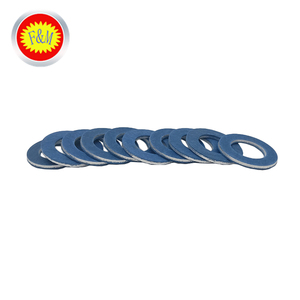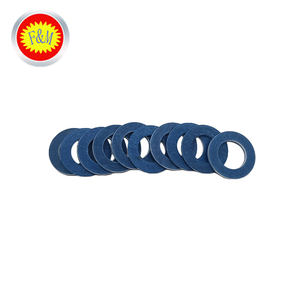(2124 products available)
















































































































































































































An oil drain gasket is a small rubber or composite material piece placed under a drain plug on an oil pan. Its main purpose is to prevent oil leaks by creating a tight seal between the oil pan and the drain plug. There are different types of oil drain gaskets, which are as follows:
Oil Drain Plug Gasket
The oil drain plug gasket, also known as the oil pan gasket, is situated at the bottom of the engine. Its role is to cover the oil pan and seal it to the engine block. This gasket prevents oil leaks by creating a tight seal around the bolts that attach the oil pan to the engine. It also minimizes oil seepage around the oil drain plug and the oil pan's threaded insert. The oil drain plug gasket is usually made of flexible rubber. Over time, it can wear out or get damaged, resulting in oil leaks. Other names for the oil drain plug gasket include the Oil Pan Gasket and Oil Pan Gasket Set.
Oil Flange Gasket
The oil flange gasket is located where the oil lines connect to the engine. Its job is to seal the connections between the oil lines and the engine to prevent oil leaks. Like the oil drain plug gasket, the oil flange gasket can deteriorate over time, causing leaks. The oil flange gasket is vital for maintaining proper oil circulation within the engine. If the oil flange gasket fails, it can lead to oil leaks and potentially low oil levels in the engine.
Oil Filter Gasket
Every oil filter has a built-in gasket that is crucial for preventing oil leaks. This gasket creates a seal between the oil filter and the engine block. It ensures that oil flows through the filter and into the engine without leaking. If the oil filter gasket fails, it can lead to oil leaks. This can result in low oil levels in the engine, potentially causing engine damage over time.
Threaded Insert Gasket
Threaded inserts are used in place of oil drain plugs on some vehicles. These inserts are threaded holes in the oil pan that allow for attaching and removing drains and filling equipment. Like the oil drain plug gasket, they need gaskets to prevent leaks around the threaded connections.
The specifications of an oil drain gasket vary depending on the type of vehicle. Here are some general specifications:
Size
The oil drain gasket comes in different sizes. The size of the oil drain gasket must match the size of the oil pan. The size of the oil pan is determined by the make and model of the vehicle. A larger oil drain gasket will leak oil, while a smaller oil drain gasket will not fit.
Material
The oil drain gasket is made from different materials. The material of the gasket affects its durability and resistance to heat and oil. Common materials for oil drain gaskets include rubber, cork, and silicone. Rubber gaskets are the most common. They are affordable and have good oil resistance properties. Cork gaskets have excellent properties, but they are not as durable as rubber gaskets. Silicone gaskets are more expensive than rubber and cork gaskets.
Thickness
The oil drain gasket has different thicknesses. The thickness of the gasket affects its ability to create a seal. A thicker gasket compresses more, creating a better seal. However, a thick oil drain gasket is difficult to install.
Maintaining the oil drain gaskets is essential, as it ensures a long lifespan and prevents oil leaks. Here are some maintenance tips:
There are several factors that wholesalers and retailers need to consider when choosing suitable oil drain gaskets for their customers. Some of the factors are discussed below.
Compatibility
Ensure the drain plug gasket is compatible with the drainage system where it will be used. Consider factors such as the size of the drain plug, the type of fluid being drained, and the material compatibility with the drained fluid.
Quality and Reliability
To avoid frequent replacements and customer complaints, choose high-quality oil drain gaskets with reliable performance.
Temperature and Pressure Resistance
For applications involving high temperature and pressure, choose oil drain gaskets that can withstand the conditions to avoid failures.
Ease of Installation
Consider the ease of installation of the oil drain gaskets. Easy-to-install gaskets minimize errors during installation and save time.
Cost
While cost shouldn't be the only determining factor, consider the affordability of the oil drain gaskets. Find suppliers that offer a variety of gaskets within different budgets, ensuring clients get value for their money.
Here are the steps to replace oil drain gaskets:
Preparation
The vehicle needs to be parked on a flat, level surface. The engine oil needs to be drained, and the new gasket should be cleaned using a scraper and the appropriate cleaning solvent.
Lifting the vehicle
The vehicle should be raised using a jack, and safety jack stands should be used to support it.
Locating the oil drain pan
The oil drain pan needs to be located. It is located underneath the vehicle, and the oil drain plug will be visible on the pan.
Removing the oil drain plug
The oil drain plug needs to be unscrewed using a wrench. Once the plug is unscrewed, oil will begin to drain from the pan.
Removing the old gasket
The old gasket should be removed from the oil drain plug and the pan. In cases of stubborn gaskets, a scraper or gasket remover can be used.
Installing the new gasket
The new gasket should be placed on the oil drain plug. A thin layer of gasket maker should be applied, and the plug should be screwed back into the drain pan.
Checking for leaks
The oil level should be checked, and more oil should be added until the proper level is reached. Once the oil is added, the engine should be started, and the oil drain should be inspected for leaks.
Q1: What Is an Oil Drain Gasket?
A1: An oil drain gasket is a small but crucial component of the oil drainage system in vehicles and machinery. It creates a tight seal around the oil drain plug, preventing oil leaks and ensuring the efficient drainage of oil during changes. Without a functioning oil drain gasket, users may face oil leaks, potentially damaging the engine and surrounding parts.
Q2: What Is an Oil Drain Gasket Made Of?
A2: Oil drain gaskets are typically made from durable, oil-resistant materials. The most common material used is rubber, particularly Nitrile Butadiene Rubber (NBR). NBR is known for its excellent resistance to petroleum-based oils and good mechanical properties. Another material is silicone, which can withstand a broader temperature range but may be more expensive. Both materials ensure longevity and reliability in sealing oil drains.
Q3: How to Identify a Bad Oil Drain Gasket?
A3: Identifying a bad oil drain gasket is crucial for maintaining vehicle health. The primary indicator of a compromised gasket is the presence of oil puddles or stains under the vehicle, suggesting a leak. If users notice wetness or dripping around the oil drain plug, it might indicate gasket wear. Additionally, low oil levels in the oil reservoir can signal a leaking drain gasket. Physical signs like cracks, tears, or warping in the gasket material are also clear indicators of damage.
Q4: How Often Should One Replace the Oil Drain Gasket?
A4: While there is no strict timeline for oil drain gasket replacement, experts recommend changing it every time the oil is changed or at least every 30,000 to 50,000 miles. Regular inspections can help maintain vehicle health and avoid costly engine damage. The frequency can also depend on the gasket material, vehicle usage, and environmental conditions. For instance, vehicles frequently exposed to harsh weather or off-road conditions might need more frequent checks.
Q5: Can One Use an Oil Drain Gasket Again After Removal?
A5: Reusing an oil drain gasket after removal is generally not advisable. Even if it looks intact, the material might have compressed or developed micro-cracks during its first use, compromising its sealing ability. This could lead to oil leaks. If reusing is considered, thoroughly inspect the gasket for damage and perform a leak test after reinstallation. However, for peace of mind and to ensure a perfect seal, replacing the old gasket with a new one is best.